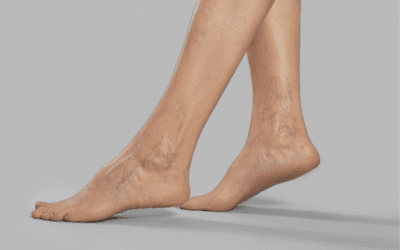| Leg swelling can range from benign and temporary to indicative of a more serious health issue. Recognizing the warning signs and seeking prompt medical evaluation is essential for your well-being. Don’t hesitate to consult with an experienced vein specialist if you have concerns about leg swelling or related symptoms. |
Leg swelling, or peripheral edema, is a common condition that can occur for various reasons. While occasional, mild leg swelling is typically harmless and often attributed to factors like prolonged standing or sitting, pregnancy, or a hot day, there are certain signs of leg swelling that should never be ignored.
These signs can be indicative of underlying health issues that require prompt attention and evaluation by a vascular surgeon. In this blog, we’ll delve into the five warning signs you should be aware of and why they warrant your concern, and will discuss the treatment options for swollen legs.
What is the Main Cause of Leg Swelling?
Leg swelling can have various causes, including:
- Fluid Retention: Accumulation of excess fluid in the tissues, often due to gravity, prolonged sitting or standing, and certain medications.
- Injury or Trauma: Injuries, sprains, or fractures can lead to localized swelling.
- Infections: Bacterial or viral infections can cause localized or generalized swelling.
- Venous Insufficiency: When the veins in the legs have difficulty returning blood to the heart, it can result in edema.
- Deep Vein Thrombosis (DVT): Blood clots in the deep veins of the legs can cause swelling and require immediate medical attention.
When Should I Worry About Leg Swelling?
While mild, occasional leg swelling may not be a cause for concern, you should seek medical attention if you experience:
- Sudden and Unexplained Swelling: This can be a sign of deep vein thrombosis (DVT), a potentially life-threatening condition.
- Skin Changes: Redness, warmth, or tightness along with swelling may indicate infection or inflammation.
- Pain and Discomfort: Leg swelling should not be painful; persistent pain may signify an underlying issue.
- Shortness of Breath: When accompanied by swelling, it may indicate heart failure.
When to Seek Medical Attention
If you experience any of these warning signs of leg swelling, it’s important not to delay seeking medical attention. Dr. Heird can perform a thorough evaluation, order diagnostic tests, and determine the underlying cause of your swelling. Timely intervention can prevent potential complications and ensure you receive appropriate treatment.
5 Warning Signs of Leg Swelling You Shouldn’t Ignore
Leg swelling, or peripheral edema, is a condition where excess fluid accumulates in the tissues of the legs. While it can be a common occurrence, it’s essential to recognize when it may indicate an underlying health issue that requires attention.
Here are five warning signs of leg swelling that you should never ignore:
- Sudden and Severe Swelling:
If you notice a sudden and severe increase in leg swelling, especially if it occurs in just one leg and not the other, it can be a cause for concern. This asymmetry could be indicative of a deep vein thrombosis (DVT) or a blood clot in the veins, which requires immediate medical attention.
- Skin Changes:
Pay attention to any skin changes that accompany leg swelling. Redness, warmth, or tightness in the affected area can be signs of infection or inflammation, which may need medical evaluation.
- Pain or Discomfort:
Leg swelling accompanied by pain or discomfort, particularly in the calf area, should not be ignored. It could be a sign of deep vein thrombosis (DVT), a condition where a blood clot forms in a deep vein. DVT can be a serious condition that requires prompt treatment to prevent complications.
- Difficulty Breathing:
Leg swelling, especially if it’s associated with sudden shortness of breath, can be a sign of heart failure or other cardiovascular issues. In heart failure, fluid can accumulate in the lungs and lead to breathing difficulties. Seek medical attention immediately if you experience this symptom.
- Swelling in Both Legs:
While some causes of leg swelling may affect only one leg, swelling in both legs can be a sign of systemic issues. Kidney problems, liver disease, and heart conditions can all cause bilateral leg swelling. If you notice swelling in both legs, consult a healthcare professional for a thorough evaluation.
How Can I Reduce the Swelling in My Legs?
You can manage mild leg swelling with these strategies:
- Elevate Your Legs: Raise your legs above heart level whenever possible.
- Compression Stockings: These can help improve blood circulation.
- Exercise: Regular physical activity can reduce fluid buildup.
- Reduce Salt Intake: Excess salt can contribute to fluid retention.
What Medical Condition Causes Swollen Legs?
Swollen legs can be linked to various medical conditions, including heart disease, kidney problems, liver disease, and venous insufficiency. Identifying the underlying cause is essential for effective treatment.
Do Swollen Legs Mean Heart Failure?
Swollen legs can be a symptom of heart failure, but not in all cases. Heart failure can lead to fluid retention, causing swelling in the legs and other areas of the body.
How Do You Know If Swelling Is Serious?
Swelling should be considered serious if it’s sudden, accompanied by skin changes, painful, or associated with shortness of breath. Such symptoms require immediate medical evaluation.
Can Leg Swelling Go Away on Its Own?
Mild leg swelling, caused by factors like prolonged standing or sitting, can resolve on its own. However, persistent or recurrent swelling may require medical evaluation.
What Are the 4 Types of Swelling?
Swelling can manifest in various ways, and it’s typically categorized into four main types:
1. Edema:
Edema is the most common type of swelling and occurs when excess fluid accumulates in the body’s tissues, leading to puffiness and enlargement. It can be localized (affecting one specific area) or generalized (affecting the entire body). Edema often occurs in the legs, ankles, and feet, but it can happen in other body parts as well.
2. Inflammatory Swelling:
This type of swelling is a response to injury, infection, or inflammation. When the body detects an injury or infection, it releases inflammatory chemicals that cause blood vessels to become more permeable, allowing fluid, white blood cells, and other immune system components to rush to the affected area. This process leads to redness, heat, swelling, and pain.
3. Lymphedema:
Lymphedema is swelling caused by an impairment in the lymphatic system’s ability to drain fluid from tissues. The lymphatic system plays a crucial role in maintaining fluid balance and immune function. When this system is compromised, typically due to surgery, radiation therapy, or certain medical conditions, it can result in chronic swelling, often in the arms or legs.
4. Idiopathic Swelling:
Idiopathic swelling refers to swelling of unknown cause. In some cases, individuals may experience swelling without a clear trigger or underlying medical condition. This type of swelling can be puzzling, and healthcare providers may need to perform further evaluation to determine its cause.
What Makes Swelling Worse?
Swelling can worsen due to factors like prolonged inactivity, excessive salt intake, and certain medications. Identifying and avoiding these triggers can help manage swelling.
Swollen legs can be harmless, but they can also indicate underlying health issues. It’s crucial to determine the cause to ensure appropriate treatment and prevent complications.
What Happens If Your Legs Stay Swollen for Too Long?
Persistent leg swelling can lead to skin changes, tissue damage, and increased risk of infection. Identifying and addressing the underlying cause is essential for preventing long-term complications.
How Long Should a Swollen Leg Last?
The duration of leg swelling varies based on its cause. Mild, transient swelling may resolve within hours or days, while chronic swelling may persist until the underlying issue is treated.
Seek Treatment From The Leading Vein Specialists in York & Lancaster, PA.
At every stage of your vein issues, it’s important to see a professional to help you heal venous insufficiency and achieve a life of normalcy and physical comfort.
Not only can they help you finally heal this condition, but they can also treat the vein issues that caused them in the first place. Visit one of our centers for an in-depth appointment and put your vein troubles to rest.
Ready to book your appointment? Give us a call today.

Dr. Steven Heird, MD, is a distinguished specialist in the treatment of venous disease and vascular surgery. As one of the dedicated doctors at the Advanced Vein and Laser Center, located in York and Lancaster, Pennsylvania, Dr. Heird has made a significant impact in the field of vein care. His expertise and commitment to patient well-being have earned him a trusted reputation among his peers and patients. Dr. Heird’s work at the Advanced Vein and Laser Center reflects his passion for providing compassionate and effective vein care, improving the lives of those he serves with precision and care.








0 Comments